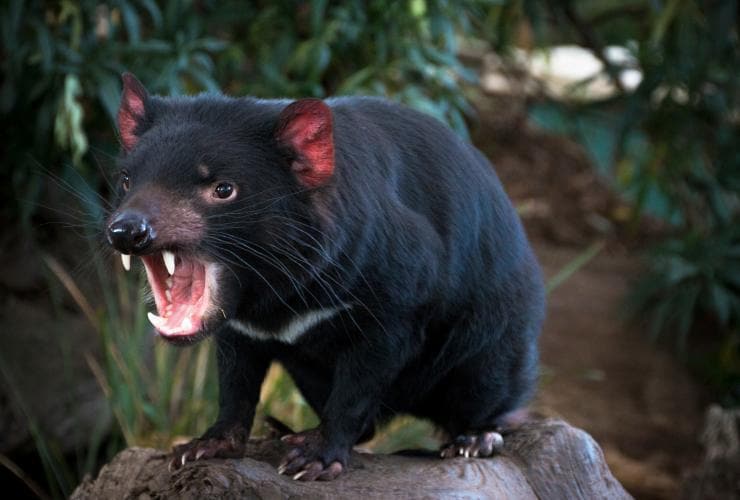Cradle Mountain National Park, TAS © Tourism Tasmania
Fun facts about Tasmanian Devils
Discover the myths, truths and totally wild trivia of these mysterious marsupials.
If a wolf howling at the moon sends shivers up your spine, wait until you hear a Tasmanian devil. In fact, the first Europeans to enter Tasmania imagined demons lurking in the bush when they heard the blood-curdling shrieks and growls. Hence being dubbed ‘devils’. It's now known that their various vocalisations (coughs, growls, snorts, sniffs, screeches and even sneezes) are designed to scare off other animals.
Tasmanian devils deliver the strongest bite-for-size of any mammal in the world! They can open their jaws up to 80 degrees and chomp down with enough brute force to crush bone. They have even been known to bite through metal, breaking the cages of livestock and other animals. Devils use their incredibly powerful jaws to consume game without any leftovers – they eat every part of their prey.
Like all marsupials, Tasmanian devils store fat in their tails, which thicken up like a human's waistline. A particularly plump tail is a sign of a healthy devil and, considering they can eat up to 40% of their bodyweight in one day, their tails can get mighty plump!
Tasmanian devils have a habit that takes eating in bed to a whole new level. They tend to nap inside a rotting carcass (called ‘carrion’) so they can wake up and continue eating. Though it may sound gruesome, by eating animal carcasses, Tassie devils actually help keep their ecosystem hygienic and free from maggots.
A mother Tassie devil gives birth to around 20-40 joeys at once. However, these joeys have to race to her pouch, which only has four teats. Talk about a hard start to life! The ones that make it will live in their mother’s pouch for roughly three months before they start to venture out on their own.
The Tasmanian devil has held this title for over 80 years. Their diet consists solely of meat, including birds, snakes and other mammals up to the size of small kangaroos, but they will also eat carrion. They put those tremendous jaws to good use, crushing and ravenously ingesting bones and all.
Tasmanian devils are very timid and don't normally pose a danger to people unless they are attacked or trapped. However, when they do feel threatened, they do strange ‘yawns’, showcasing their sharp teeth. While this looks quite fierce, it is actually more a display of fear and anxiety than aggression.
Younger Tasmanian devils are more agile than older ones, even to the point of being able to climb trees. This adaptation is useful as adult devils have been known to eat younger ones if they are very hungry, and climbing allows them to escape. Tasmanian devils are also incredible swimmers and can run at 24km per hour (15mi per hour) for up to an hour!
Tasmanian devils have been considered an endangered species since 2008; one of the primary causes of death is being hit by cars when they attempt to retrieve roadkill. In addition, a serious disease has affected some populations. The only known contagious cancer, this disease causes tumors to build up in affected animals' mouths, which stops them from eating. Tens of thousands of Tasmanian devils have died since the disease appeared in the late 90s.
Through the program #DevilComeback, the conservation group Aussie Ark is reintroducing devils to the Australian mainland, where they have not lived for over 3,000 years. The reintroduction plan will see them thrive and breed in an area free from the contagious cancer that has affected so much of the Tasmanian population of devils.







































































































































